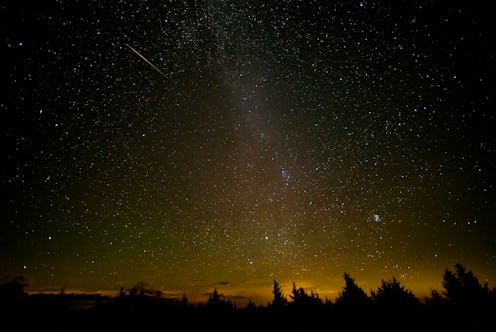Although it may not seem like it, winter is the perfect time to reconnect with nature. Sure, it's tempting to curl up inside and hide from the cold, but getting fresh air and communing with the outside world can be really beneficial. That's why it's good to know how to watch the Geminid meteor shower when it reaches us shortly. Because between the stress of the holidays, people who may be struggling with seasonal depression or anxiety, or just having spent too much time inside lately (hi there, Gilmore Girls marathon), it's about time we get off the couch and watch the sky light up. Plus, it never hurts to find free activities during gift-giving season.
The Geminid meteor shower will peak in the second week of December this year. While the best days to see it can range anywhere between between Dec. 12 and Dec. 15, experts estimate that in 2016, the Geminid meteor shower will peak on the night of Dec. 13 at around 2 a.m. (and no matter where you are located on the globe, at that). Luckily for us, the Geminid meteor shower is reliably good, meaning that year after year, we tend to have a good showing and good visibility, even if you don't have professional equipment or tons of celestial knowledge. While it's true that this year, the December supermoon might interfere just a bit, you'll likely still be able to spot a couple of shooting stars.
Here's what you need to know to have a good time viewing the Geminid meteor showers. Don't forget to pack a blanket and some hot chocolate!
1. Leave Your Equipment At Home
According to In-The-Sky.org, the Geminid meteor shower should be visible to the naked eye. If you have a telescope or other fancy equipment, by all means, use it — but if you don't, don't feel discouraged. This is one of the more amateur-friendly meteor showers.
2. Get Away From The City
If you live in the city, it's a good idea to get out of it so you can catch the meteors in all their glory. In largely populated areas, things like light pollution and tall buildings can obstruct your view; they're less of an issue when you get further away, though, so head out to a rural area if you can.
3. Find Some Wide Open Sky
Even when you're outside of a city, you want to make sure you choose a spot where you have a nice view of the entire sky. The Geminids can come from any direction and don't follow a predictable pattern, so the wider the scope, the better.
4. Get There At Least 20 Minutes Early
As EarthSky explains, you'll want to give your eyes at least 20 minutes to adjust to the darkness; once this happens, you'll have a more comfortable time spotting the meteors. Since the shower is expected to peak at around 2 o'clock in the morning, you'll want to head outside sometime around 1:30 or 1:40 at the latest.
5. Give Yourself An Hour Of Viewing Time
EarthSky recommends giving yourself at least an hour long to actually view the meteor shower, as it can go in and out of frequency.
6. Watch A Live Stream
Can't get outside? The Slooh Observatory will be live streaming the meteor shower starting at 8pm on Dec. 13. Because sometimes, you just need access to these sorts of things from the comfort of your own home.
Have fun, everybody! And remember to stay warm!
Images: Getty Images; Giphy (6)
